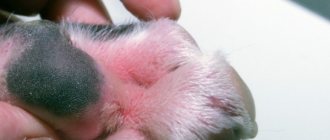Due to the structure of the skull and the shape of the eyelid, pugs often suffer from eye diseases. Tears, redness, and swelling are alarming and make you frantically look for ways to help your pet before visiting the veterinary clinic.
What eye diseases exist in dogs of this breed? What should you buy in your home medicine cabinet? When is it better not to delay visiting a doctor? Read our article!
Home care
You should start monitoring the condition of your pug's eyes 10 days after his birth. It is then that his eyes begin to open, and are visible from under the raised eyelid from the inner corner. The immunity of ten-day-old puppies is not yet strong enough, and if a nursing mother has conjunctivitis, it is likely to be passed on to the offspring.
Important! If your female pug has eye problems, treat them before treating her with a cable. This way you will prevent the possible development of diseases in future offspring.
You can keep your pug's eyes healthy by regularly following these rules:
- Check the corners of your eyes for dirt every day, especially after walking, and wipe them with a damp cloth.
- Monitor the state of lacrimation. If your eyes begin to water intensely or, conversely, become dry, this is a reason to consult a doctor.
- Make sure that while walking, litter, dust and sand do not get into the pug’s eyes.
- Make sure that the pug is not exposed to the wind or draft for a long time.
- Make sure your veterinary medicine cabinet is full so that you always have the necessary medications at hand.
What to wash and drip with?
If you are the owner of a pug, make sure that your veterinary medicine cabinet always contains the following medications:
- physical solution;
- chloramphenicol;
- tetracycline ointment;
- antiallergic drugs (tavegil, suprastin);
- tsiprovet.
Almost all of the above pharmaceuticals can be purchased at a regular “human” pharmacy. Having them at hand, you can be sure that, if necessary, you will be able to provide first aid to your pet and alleviate its condition before a medical examination.
What discharge from the eyes is considered normal?
Many dogs experience mucous accumulation in the inner corners of their eyes after sleep. They can be transparent with a grayish or slightly reddish tint.
Also, dog breeds that have certain structural features are predisposed to excessive tearing. Discharge from the eyes can be observed throughout the day from an early age. These are the breeds:
- with drooping eyelids (basset hound, sharpei, spaniel, mastiff, cane corso, etc.)
- with bulging eyes (Pekingese, Japanese Chin, Chihuahua, Pugs, etc.)
- with a brachycephalic muzzle structure (bulldogs, pugs, Pekingese, griffins, boxers, etc.)
- with long hair on the head (Yorkshire terrier, Shih Tzu lapdog, poodle, etc.)
Older dogs develop a cloudy cornea as a result of a lack of tear fluid. This process is accompanied by mucopurulent discharge in the eyelash area and chronic conjunctivitis.
Red squirrels
There may be three reasons why a pug’s eyes may be red:
Conjunctivitis
An inflammatory process caused by pathogenic bacteria or viruses entering the mucous membrane. With bacterial conjunctivitis, the eye becomes red and purulent discharge appears; with viral conjunctivitis, slight clear mucus appears.
Bacterial damage to the organs of vision should be treated with antibacterial drops and ointments. Perfect for this purpose:
- Tsiprolet;
- Phloxal;
- Levomycetin (drops);
- Tetracycline (ointment).
In case of a viral infection, it is enough to rinse the eyes with saline. solution until improvement occurs. If after 5 days of intensive treatment there is no improvement, be sure to visit a veterinarian.
Keratitis
With keratitis, redness of the eyes is accompanied by attacks of photophobia. The dog constantly closes its eyes in the light, and sometimes cannot open its eyelids at all.
Reference! In pugs, keratitis develops due to the growth of the nasal fold. Increasing in size, it begins to touch and damage the cornea of the eye.
In the early stages, the disease can be treated with medication under the supervision of a doctor. As it progresses, keratitis can lead to loss of vision or the vital need for surgical removal of the eye.
Entropy
Entropy is a disease caused by the appearance of an extra fold on the eyelid (most often the upper one). The eyelashes curl inward and put pressure on the eyeball. The disease can be detected only at six months of age and later. In particularly difficult cases, the problem is solved by surgical shortening of the eyelid.
Hazardous factors
bacterial infection (pseudomonas aeruginosa, cocci, etc.); viral attack (herpes virus, adenovirus); fungal infection; allergy; avitaminosis; systemic, autoimmune or neurological pathologies.
In some cases, the cause of keratitis cannot be determined.
The cause of keratitis in dogs can be either a disease or an eye injury.
READ How to stop a cat from shitting in the wrong place, anywhere. Why did a cat start shitting anywhere, what to do: shitting during heat, an adult cat shitting. What to do if a cat starts shitting
Some dog breeds have a natural predisposition to this disease. These include:
- boxers;
- French bulldogs;
- pugs;
- Pekingese and others.
- The main symptom is clouding of the cornea, which occurs very quickly, literally within a few hours. The surface of the cornea becomes white-bluish or ash-gray, as if rough.
- The animal avoids the light, squints, tears flow from its eyes. Later, vessels begin to grow into the cornea of the eye from the periphery, making it practically opaque, uneven, and gray-red in color.
- With superficial purulent keratitis, purulent exudate is released. The cornea swells and becomes whitish-yellow. The disease can develop into a corneal ulcer.
- With superficial vascular keratitis, connective tissue grows into the cornea along the vessels.
- Phlyctenular keratitis is most often observed in collies, German and East European shepherds. With a long course of the disease, the third eyelid thickens and becomes lumpy. Round nodules of a grayish color appear on the cornea. Over a long period of time, they merge, become ulcerated, and the cornea becomes gray-red and lumpy.
- Deep (parenchymal) keratitis is characterized by an edematous cornea of white or white-yellow color. Conjunctivitis and iritis often appear.
- To relieve inflammation, the conjunctival sac is washed with antiseptic solutions: furatsilin, 1% rivanol, 2-3% boric acid.
- Superficial catarrhal keratitis is treated with drops of a 20-30% solution of sodium sulfacyl or 0.25% solution of chloramphenicol in combination with subconjunctival injections of 0.5-1 ml of 0.5% solution of novocaine and 0.1-0.2 ml hydrocortisone. Antibiotic eye ointments are also used 2-3 times a day.
- For superficial vascular keratitis, resorption therapy is additionally prescribed: the vitreous is injected subcutaneously every day for 20-30 days and 4-5 injections of placenta suspension are given.
- For phlyctenulous keratitis, vitamin drops are needed in the conjunctival sac and 30 intramuscular injections of vitamin B6. A salt-free and carbohydrate-free diet with multivitamins is also prescribed.
Tears
Here are some reasons why your pug may be crying and blinking non-stop:
- Keratoconjunctivitis. Inflammation and increased lacrimation are caused by insufficient secretion of eye mucus and drying out of the apples. Treatment is selected by a veterinarian on an individual basis.
- Bringing debris into the eye - during a walk, sand or debris could get into the dog's eye, which causes irritation and tears. Carefully inspect your pet's eyes and if you find debris, thoroughly rinse the eye with physical water. solution.
What to wash with?
Sterile saline sodium chloride solution 0.9%In small ampoules its cost is 25-30 rubles. You can purchase a bottle with a volume of 100 ml or more, provided that sterility is maintained during use. The price of a bottle is from 30 to 50 rubles. |
FuracilinReady solution. It is a good antiseptic and is used to wash the dog’s eyes both in the treatment and prevention of inflammation of various types. A ready-made solution for eye treatment can be purchased at a pharmacy to order. Pills. You can prepare an aqueous solution in a ratio of 1:5000 (this is exactly the concentration that is needed) at home. To do this, one tablet of furatsilin (20 mg) is diluted in 100 ml of sterile warm or hot distilled water. The solution is considered ready when the active substance is completely dissolved and nothing settles at the bottom. The cost of one package of furatsilin tablets ranges from 50 to 80 rubles. |
Chlorhexidine solutionPharmacies sell a solution with a concentration of 0.05%. Dogs can have their eyes washed with a 0.01% chlorhexidine solution. To prepare the required concentration, take 4 ml of 0.05% chlorhexidine solution into a sterile 20 ml syringe and dilute to 20 ml with sterile saline. Cost 20 rubles. |
You can brew chamomile flowers to treat your eyes.It is more convenient to purchase dry chamomile in special filter bags. Place 1 sachet in a glass of hot water and leave for 15-20 minutes. The solution can be used after cooling it first. The cost of one package is about 60 rubles. |
Black teaThis is one of the most popular and always available eye cleansers. A weak brew, prepared the day before the intended use, is better suited, that is, it is not recommended to use freshly brewed tea. |
READ Why does a cat lick after castration?
Fester
Suppuration and sticky yellow-green crusts on the eyes are a sign of conjunctivitis that has developed as a result of a staphylococcal or streptococcal infection.
In the initial stages, you can get rid of the disease yourself by washing with saline solution and instilling antibiotic eye drops (Levomycetin or Floxal). In the absence of drops, you can use tetracycline ointment.
The procedure must be repeated three times a day. If there is no improvement on day 5, contact your veterinarian. He will select more effective treatment methods for your pet.
Why did the spots appear?
If your pug has strange spots on its eyes, you should not hesitate to visit a doctor. The cause of the disease in most cases is pigmentous keratitis. Pugs are susceptible to this disease for a variety of reasons:
- turning of the eyelids;
- trichiasis;
- districhiasis;
- dry eye syndrome;
- lagophthalmos.
Pigmentous keratitis requires intensive treatment under medical supervision. If the disease is left to chance, the dog may go blind or lose an eyeball.
Urolithiasis in Pugs
Pugs often develop urolithiasis.
Urolithiasis in pugs is a very common occurrence.
Symptoms may include:
- Frequent urination in the dog.
- The pug licks its genitals more often than usual.
- Urine changes color to more cloudy. Sometimes you can see pus in it.
- Poor health of the dog, expressed in refusal to eat, apathy and lethargy.
The first step is to get rid of stagnant urine, so the veterinarian prescribes diuretics. Further treatment will depend on the specific case and the size of the stones. In some cases, there is nothing left but to undergo surgery.
Cloudy film and eyesore
A cloudy eye, as if covered with a whitish film, in most cases is a consequence of injury. Only a veterinarian can accurately determine the cause and extent of the damage, as well as select the appropriate treatment. In most cases, treatment with antiviral, wound-healing or antibacterial drops is prescribed.
If the consequences of the injury are not treated in a timely manner, an incurable thorn will form on the eye, which will affect the pet’s visual acuity.
What to do if you are injured?
In pugs, like other brachycephalics, the eyes are injured very often. If you notice that the eye is red, watery and swollen, consult the contents of your veterinary medicine cabinet. Levomycetin or tetracycline ointment will help relieve signs of inflammation, and eye drops will reduce tearing on the damaged cornea.
Reference! In some cases, large debris may get into the eye, which, sinking into the folds of the eyelid or tear ducts, causes severe discomfort to the pet. It can only be obtained using a special medical instrument in the veterinarian’s office.
Bulging
Pugs have a rather specific skull structure due to which their eyes are essentially protected only by their eyelids. Severe stress, old age, weakened immunity can lead to eyeball loss.
It is quite difficult to confuse this phenomenon with something else. The pet looks scary - its eyeball looks huge and protrudes from its socket. It is covered with small vessels and is very watery.
The owner’s main task in this situation is to calm down and do everything possible to preserve the health of the animal. Act clearly and quickly, following the following instructions:
- Rinse the eye generously with saline. solution.
- Secure a sterile napkin on it with a bandage.
- Take your dog to a veterinarian immediately or call a doctor at home.
The specialist will set the eye back in place and tell you what care the animal will need in the future.
Strabismus
Strabismus, or strabismus, can occur in dogs of all breeds and ages. As for pugs, strabismus often occurs due to birth trauma. Accordingly, if the pathology is congenital, there is no need to do anything about it, since the dog does not experience discomfort or visual disturbances.
But it also happens that the cause of strabismus is a skull injury or an infectious disease. In this case, the possibility and need for treatment is selected by the doctor individually - this could be chemotherapy, a course of antibiotics or surgery.
Why dogs have red eye and how to treat it
When faced with red eye, the physician must consider three main differential diagnoses: conjunctivitis, anterior uveitis, and glaucoma. Additional diseases such as episcleritis and panophthalmitis can also cause red eye, but are much less common.
Treatment of “red eye” in dogs begins after an accurate diagnosis.
Drops "Bars" are prescribed for washing the eyes in case of injuries, prevention and treatment of conjunctivitis, keratitis and blepharitis (dropper bottle).
Drops "Iris" - for acute and chronic conjunctivitis, keratitis, keratoconjunctivitis, blepharitis, iridocyclitis (uveitis), dacryocystitis, septic ulcers of the cornea, barley and other infections of the anterior segment of the eye, traumatic injuries of the eyeball and adjacent tissues (dropper bottle).
Ciprovet drops are also used for dogs and cats.
When prescribing medications for “red eye” in dogs, it is recommended to remember that one drop of medication is enough for one administration, and a smaller part of this drop penetrates into the eye. For chronic diseases, drops are instilled from two to six times a day, and for acute diseases - from eight to ten.











